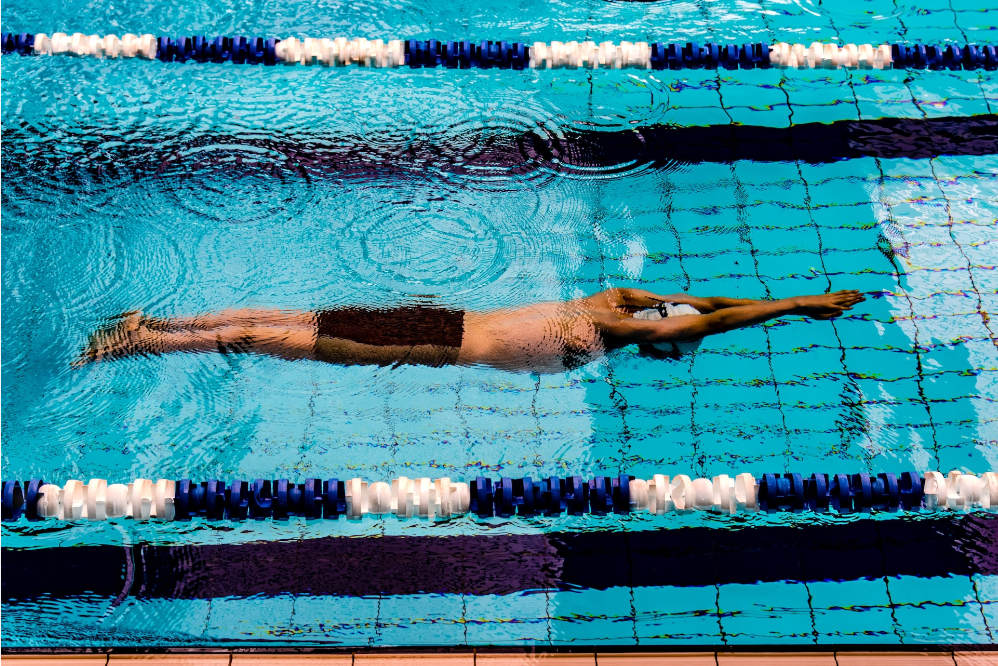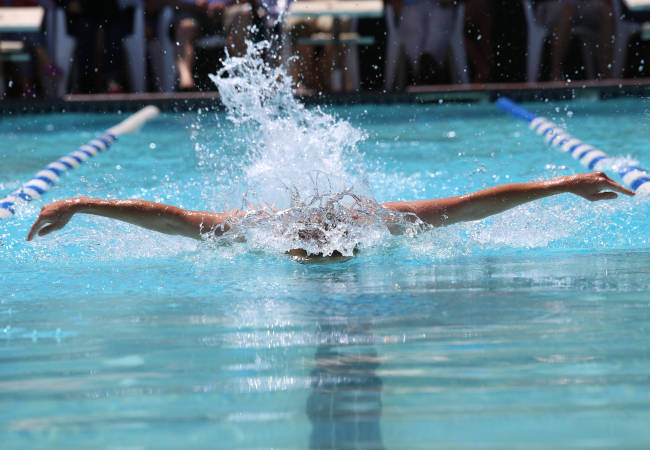Butterfly, also called dolphin, is the most challenging swimming style. Below are a few tips to hopefully help you glide elegantly and powerfully through the water.
Dynamic, powerful, explosive: These associations spring to mind when we think of butterfly swimming. It’s impressive when professional swimmers dive the first 15 meters through the pool after a dive with outstretched arms and eyes down. The body moves in an elegant wave motion, the closed legs wag up and down at high frequency. And then comes the magic moment when the swimmer takes a deep breath, explosively lifts his/her arms out of the water, and performs a tremendous “wing flap” forward.
Because of this movement, the official name is the butterfly. The second fastest swimming style, after the front crawl, is an evolution of the breaststroke. It is not only highly strenuous but also technically the most demanding swimming style. Butterfly swimming competitions are only held over short distances of up to 200 meters.
The butterfly technique is just right if you are looking for a sporting challenge while swimming. With butterfly, the muscle build-up is high, and you burn tons of calories.

History of the butterfly swimming style
An evolution of the breaststroke technique, the butterfly is the youngest of four styles, including the front crawl and backstroke. Butterfly made its debut at the 1956 Olympics in Melbourne over the 200-meter distance, and butterfly swimming has been part of the Olympic program ever since.
Long track world record holder over 100 meters and 200 meters has been Michael Phelps (USA) since 2009.
Body position in the butterfly stroke
In the butterfly stroke, proper body position is vital. The swimmer should start by lying in the water with their arms extended overhead. From there, they should arch their back and raise their legs so that their body forms a crescent moon shape. Next, they should tuck their chin and begin dolphin kicking. As they kick, they should extend their arms forward and bring them back to their sides. Finally, they should reach up with their hands and return to the starting position. Following these steps, swimmers maintain the proper body position throughout the butterfly stroke.

Arm stroke
The arm stroke in the butterfly is unlike any other swimming stroke. Most strokes involve circular motion, but the butterfly stroke is more of a figure eight. Keeping your arms parallel to your body and moving them synchronously are the keys to a good butterfly stroke. This can be difficult to master, but you’ll swim like a fish once you get the hang of it.
Just remember to keep your arms parallel and move them in a figure-eight motion, and you’ll be sure to impress your friends with your killer arm stroke in the butterfly stroke.
Leg stroke
The butterfly stroke is a beautiful thing to watch. When done correctly, it looks like the swimmer is floating on the water, their legs kicking gracefully in unison. But many people don’t realize that a lot of legwork is involved in this stroke. The leg stroke is one of the most critical aspects of the butterfly stroke.
Without a firm leg stroke, swimmers would quickly tire, and their speed would drop dramatically. So the next time you’re watching someone swim the butterfly stroke, take a moment to appreciate the strength and power of their legwork. It’s truly impressive!
Breathing in the butterfly stroke
The sport of swimming is great for working out and enjoying the water, but it can also cause breathing problems. The butterfly stroke is a perfect example of this. To breathe correctly while swimming the butterfly, you must inhale through your nose and exhale through your mouth. Sounds simple enough, right? Well, it turns out that it’s actually quite challenging to do, more so while swimming.
If you don’t exhale fully before inhaling, you’ll end up swallowing water, and if you inhale too deeply, you’ll take in too much of the chlorinated pool water, which can be nasty. So the next time you’re swimming laps, take a few deep breaths and practice your butterfly stroke breathing technique. Otherwise, you might end up with a mouthful of water. Trust me, it’s not worth it.

Conclusion: Learning the butterfly is easier this way
Mastering the correct butterfly technique is a challenge. For beginners, it is advisable first to learn how to swim breaststroke and front crawl correctly. Once these two styles are in place, you can move on to butterfly swimming.
Consider these tips an incentive to have a swim coach at a swimming school show you how to do it properly. He or she will correct incorrect posture directly and prevent incorrectly internalized movements from having to be painstakingly retrained at some point.



















